Xylophanes tyndarus
|
| left">
Updated as per
AN ANNOTATED CHECKLIST OF THE SPHINGIDAE OF BOLIVIA, October 2007
Updated as per http://www.pybio.org/SPHINGINAE.htm (Paraguay), October 2007
Updated as per More, Kitching and Cocucci's Hawkmoths of Argentina 2005, October, 2007
Updated as per personal communication with Johan van't Bosch (Mato
Grosso, Brazil, September 20), March 2008
Updated as per personal communication with Kirby Wolfe (Santa Rosa, San Jose, Costa Rica), January 2009
Updated as per "A Hawk Moths fauna of southern Maranhão state, Brazil, ... "; NEVA: Jahrgang 34 Heft 3 November 2013; via Jean Haxaire; April 5, 2014
Updated as per personal communication with Sergio D. Ríos Díaz in CATÁLOGO DE LOS SPHINGIDAE (INSECTA: LEPIDOPTERA) DEPOSITADOS EN
EL MUSEO NACIONAL DE HISTORIA NATURAL DEL PARAGUAY; sent to me in July 2014 by Sergio D. Ríos Díaz.
Updated as per personal communication with Ezequiel Bustos (Shilap revta. lepid. 43 (172) diciembre, 2015, 615-631 eISSN 2340-4078 ISSN 0300-5267), January 4, 2016
|
Xylophanes tyndarus
zail-AH-fan-eesMTIN-dahr-us
(Boisduval, [1875]) Choerocampa
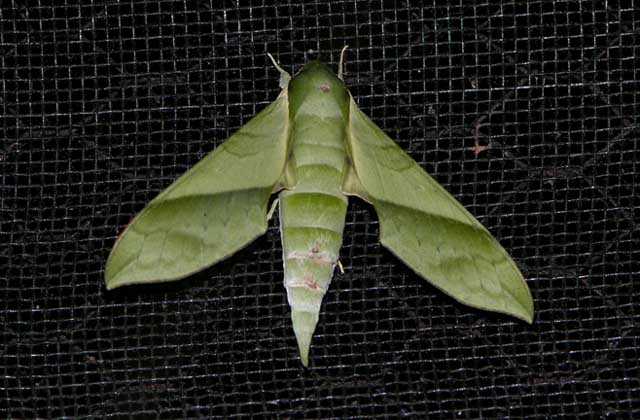
Xylophanes tyndarus, Cristalino Jungle Lodge, Mato Grosso, Brazil,
September 23, 2007, 71m, courtesy/copyright of Johan van't Bosch.
This site has been created by Bill Oehlke.
Comments, suggestions and/or additional information are welcomed by Bill.
TAXONOMY:
Family: Sphingidae, Latreille, 1802
Subfamily: Macroglossinae, Harris, 1839
Tribe: Macroglossini, Harris, 1839
Genus: Xylophanes Hubner [1819] ...........
Species: tyndarus Boisduval, [1875]
|
DISTRIBUTION:
Xylophanes tyndarus moths [wingspan 75-86 mm, females larger than males]
fly in
Mexico;
Belize: Cayo, Stann Crek, Toledo;
Guatemala: Izabal (JM);
Nicaragua: Jinotega;
Costa Rica: San Jose;
probably throughout Central America;
to Brazil (specimen type locality); southern Maranhao; and
westward into
Bolivia: Santa Cruz: Guarayos, Perseverancia,
La Paz: Murillo, Río Zongo, (750m);
Paraguay: Concepcion,
San Pedro, Central, Cordillera, Paraguari, Guaira, Caaguazu
(possibly southern Presidente Hayes (WO??));
(probably Argentina: Misiones (WO??)). As of January 21, 2015, I
have no confirmed reports of tyndarus in Argentina. Perhaps it does not fly there, but I would not be surprised to someday see documentation
for it in Argentina. Bill Oehlke Ezequiel Bustos now (December 2015) confirms it in Misiones, Argentina.
marginalis B. P. Clark, 1917, Brazil, is a synonym for
Xylophanes tyndarus.
f. subtyndarus Hoffmann, 1936, Brazil, is the same as
Xylophanes tyndarus.
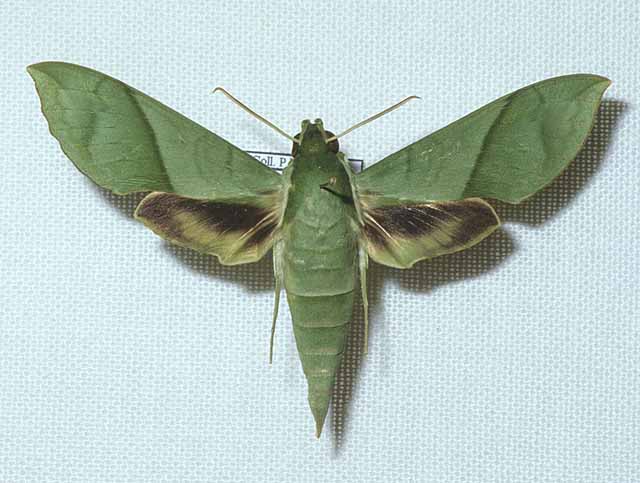
Xylophanes tyndarus male courtesy of
Hubert Mayer
copyright.
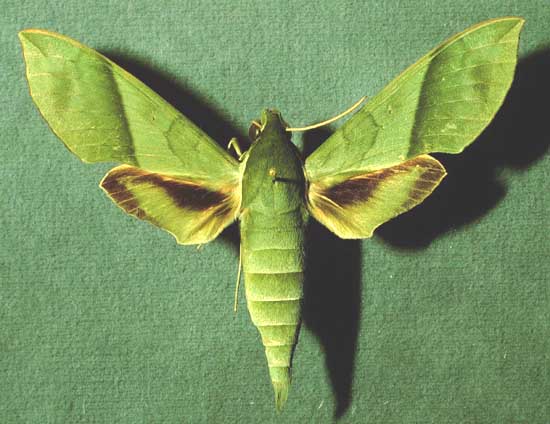
Xylophanes tyndarus male courtesy of Dan Janzen.
FLIGHT TIMES:
Xylophanes tyndarus adults probably
have at least two flights annually. In Costa Rica moths are taken
November through February and then again from April through July.
Johan van't Bosch reports a September flight in Mato Grosso, Brazil.
Sergio Rios Diaz reports September-October flight in Paraguay.
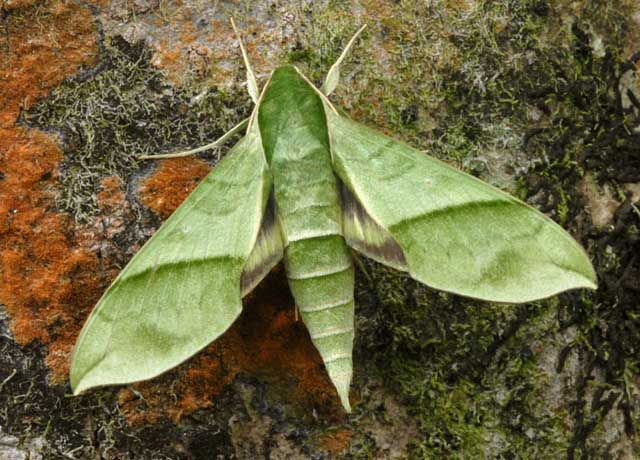
Xylophanes tyndarus, Santa Rosa, San Jose, Costa Rica, April 9, 2008, courtesy of Kirby Wolfe.
ECLOSION:
Pupae probably wiggle to surface from subterranean chambers just prior to eclosion.
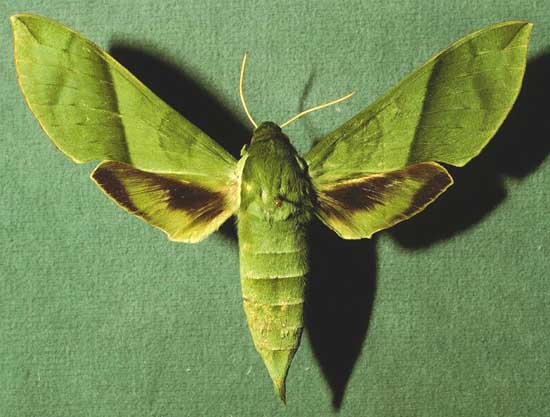
Xylophanes tyndarus female courtesy of Dan Janzen.
SCENTING AND MATING:
Females call in the males with a pheromone released from a gland at the tip of the
abdomen. Males come in to lights very readily, but females are seldom taken in that way.
EGGS, LARVAE, PUPAE:
Larvae feed on Faramea occidentalis and probably other
plants in the Rubiaceae family. Larvae in early instars are green with yellow eyes, and feed solely on new leaves.
They turn brown in last instar and have a yellow eye ring that looks just like that of X. anubus.

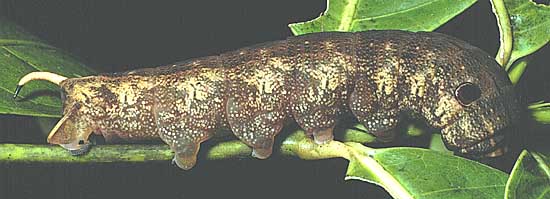

Moths emerge approximately twenty to thirty days after pupation. The eye region is pronounced giving the head a very angular appearance
in a grey-beige, mottled pupa. | 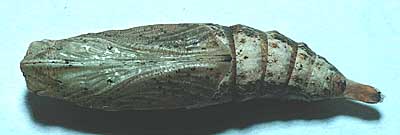 |
The pronunciation of scientific names is
troublesome for many. The "suggestion" at the top of the page is
merely a suggestion. It is based on commonly
accepted English pronunciation of Greek names and/or some
fairly well accepted "rules" for latinized scientific names.
The suggested pronunciations, on this page and on other pages,
are primarily put forward to assist those who hear with internal
ears as they read.
There are many collectors from different countries whose
intonations and accents would be different.
Jean Marie Cadiou writes, "When I say "Xylophanes" in English I
pronounce it something like "Zailophanees", with the emphasis on the
"o". The French pronounce it differently, something like
"Kzeelophaness" with no emphasis, and the Germans yet in a
different way..."
Some of the early describers/namers chose genus
and species names indicating some character of the insect, but more
often, they simply chose names from Greek or Roman mythology or
history.Those species names which end in "ensis" indicate a
specimen locale, and those which end in "i", pronounced "eye", honour
a contempory friend/collector/etc.
In Greek myth, Phanes is the golden winged Primordial Being who
was hatched from the shining Cosmic Egg that was the source of the
universe. He personifies light emerging from chaos.
"Xylo" is the Greek word for wood.
The specimen type for the genus
Xylophanes is Xylophanes anubus. Perhaps ? when Hubner
examined that species, the yellow-orange and brown tones of the
forewings suggested wings of wood.
Tyndarus, in classical mythology, is the mortal husband of
Leda.
Use your browser "Back" button to return to the previous page.
Goto Main Sphingidae Index
Goto Macroglossini Tribe
Goto Central American Indices
Goto Carribean Islands
Goto South American Indices
Goto U.S.A. tables








